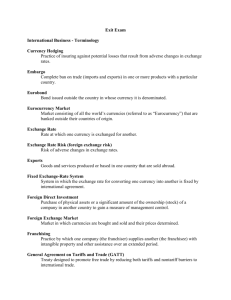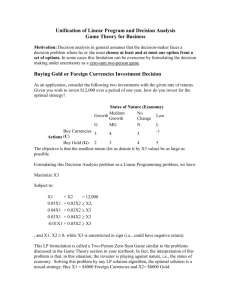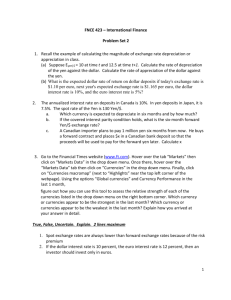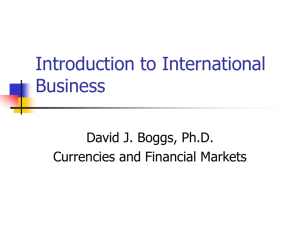IV. Questions: What is the most appropriate currency exchange regime... floating, or a hybrid of the two? How can this...
advertisement
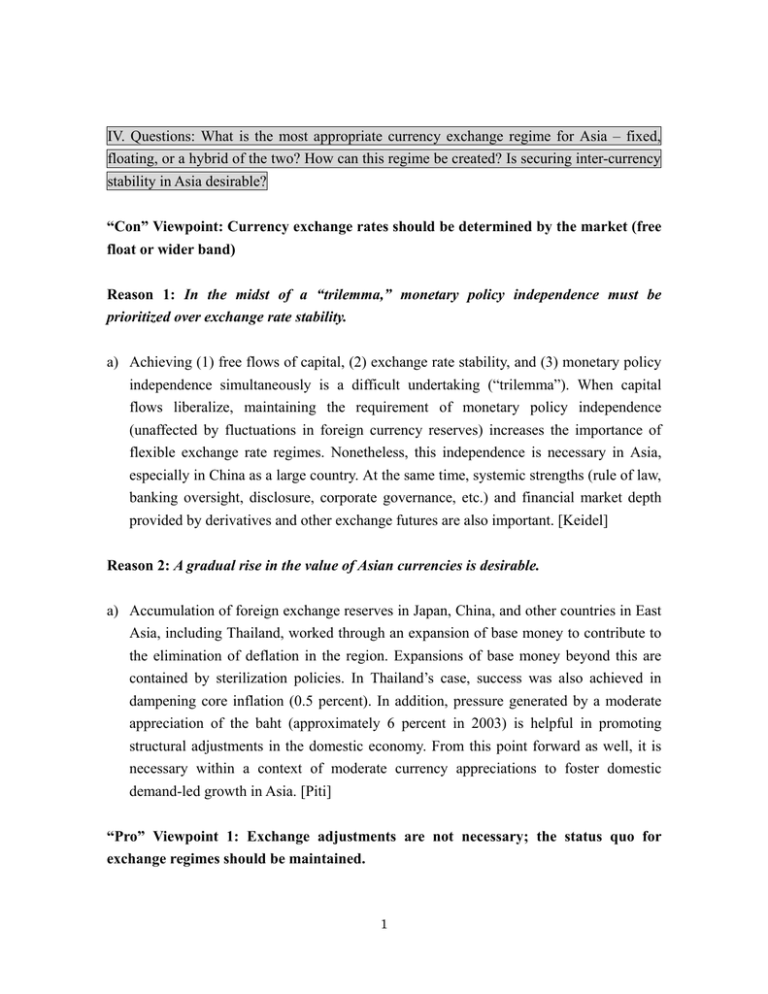
IV. Questions: What is the most appropriate currency exchange regime for Asia – fixed, floating, or a hybrid of the two? How can this regime be created? Is securing inter-currency stability in Asia desirable? “Con” Viewpoint: Currency exchange rates should be determined by the market (free float or wider band) Reason 1: In the midst of a “trilemma,” monetary policy independence must be prioritized over exchange rate stability. a) Achieving (1) free flows of capital, (2) exchange rate stability, and (3) monetary policy independence simultaneously is a difficult undertaking (“trilemma”). When capital flows liberalize, maintaining the requirement of monetary policy independence (unaffected by fluctuations in foreign currency reserves) increases the importance of flexible exchange rate regimes. Nonetheless, this independence is necessary in Asia, especially in China as a large country. At the same time, systemic strengths (rule of law, banking oversight, disclosure, corporate governance, etc.) and financial market depth provided by derivatives and other exchange futures are also important. [Keidel] Reason 2: A gradual rise in the value of Asian currencies is desirable. a) Accumulation of foreign exchange reserves in Japan, China, and other countries in East Asia, including Thailand, worked through an expansion of base money to contribute to the elimination of deflation in the region. Expansions of base money beyond this are contained by sterilization policies. In Thailand’s case, success was also achieved in dampening core inflation (0.5 percent). In addition, pressure generated by a moderate appreciation of the baht (approximately 6 percent in 2003) is helpful in promoting structural adjustments in the domestic economy. From this point forward as well, it is necessary within a context of moderate currency appreciations to foster domestic demand-led growth in Asia. [Piti] “Pro” Viewpoint 1: Exchange adjustments are not necessary; the status quo for exchange regimes should be maintained. 1 Reason: There are concerns that a rapid liberalization of capital flows could trigger a financial crisis in China similar to that which occurred in Asia in 1997. a) Especially in China’s case, the current weakness of this country’s domestic systems infrastructure makes the combination of a fixed exchange rate system and capital flow controls desirable. Pegging the renminbi to the dollar as an anchor is also helping to stabilize domestic inflation. However, what if the dollar suddenly loses 30 percent of its value? In that case, pegging to a higher level system makes it possible to compensate for the lag that occurs while the Chinese system is still weak. In addition, this provides time to upgrade domestic systems and prepare for the introduction in the future of an elastic exchange rate. [Liu] b) The quality of systems required for financial markets to function smoothly (ranging from the rule of law to corporate governance, etc.) was scored (quantified) across different countries (by the Asian Development Bank Institute). With 10 as a perfect score, Japan received a 7, Hong Kong and Singapore a 6.5, and countries in Asia that were battered by the Asian Financial Crisis, a 4.5. In contrast, China’s score was only 1.6. If the quality of China’s systems infrastructure is in fact only at this level, there is concern that a liberalization of capital flows could trigger a financial crisis in that country similar to that which occurred in Asia in 1997. [Yoshitomi, Liu] c) It is possible that membership in the WTO will accelerate the liberalization of domestic financial services. It is also possible that the penetration of foreign financial institutions will result in the de facto liberalization of capital accounts with free exchange of renminbi and foreign currencies. If capital account liberalization takes place while the upgrading of systemic infrastructure remains inadequate, some sort of crisis may occur. China thus finds itself in a race against time to build this infrastructure as quickly as possible. [Yoshitomi] d) In general, although exporters in emerging economies are quite vocal in their demands that fixed exchange rates be maintained, political and social resistance to the liberalization of capital flows is quite limited. As a result, there is a tendency to conclude that borrowing from abroad is a good idea if the interest rates offered are 2 attractive. An emerging economy where systemic infrastructure is fragile, it is easy for this to create mismatches between the timing of lending and borrowing, as well as currency mismatches. The danger that a crisis much like the 1997 Asian Financial Crisis will occur in China is therefore increasing. [Keidel] “Pro” Viewpoint 2: Coordinated currency adjustments and new exchange regimes in East Asia are required to cope with a situation in which the value of the U.S. dollar declines sharply. Reason 1: A coordinated appreciation of Asian currencies and the yen will lighten the burden of adjustment for a Japanese economy struggling with deflation. a) In the event that the value of the U.S. dollar drops sharply, the effect on the Japanese economy will differ greatly depending upon whether only the currencies of advanced countries, including Japan, appreciate and other Asian currencies are fixed, or all currencies, including Asian currencies, appreciate together. For example, imagine a scenario in which the dollar suddenly loses 22.5 percent of its value. If Asian currencies are fixed, the currencies of advanced countries, including Japan, will appreciate by an effective rate of 30 percent. If, however, the values of Asian currencies rise along with other currencies, the large proportion of trade with Asia in Japan’s total trade will hold the yen’s appreciation to an effective rate of only 6 percent. Other estimated effects are the following: If Asian currencies are fixed, Japan’s real GDP will decline 2.1 percent, and the inflation rate will be -5.7 percent. If Asian currencies rise with other currencies, real GDP will decline 1.4 percent and inflation will be -1.7 percent. These figures demonstrate how extremely difficult it would be for Japan to rid itself of deflation if currency adjustments in Asia are not coordinated. [Brook] Reason 2: It is important to be mindful of the integration of commerce in regions characterized by triangular trade. a) The pattern of global triangular trade has a large impact on bilateral trade imbalances, and this is especially true in the case of the China-U.S. trade imbalance. Bilateral trade imbalances such as this can easily become politicized. However, while the issue of 3 exchange rates should be discussed in the context of multilateral trade imbalances, it should not be raised in the context of bilateral trade imbalances. In fact, the appreciation of the renminbi will contribute little to a correction of the China-U.S. bilateral trade imbalance. [Lemoine] Reason 3: If compatibility with Asia’s economic integration is valued, stability among currencies is important. a) As much as is possible, East Asia should be integrated along the three dimensions of trade and FDI, capital flows, and currencies (exchange rates) even further. For example, even if Asian currency rates from 1999 to 2003 had adopted a basket of currencies consisting of the yen, the dollar, and the Euro (i.e., the G-3 currencies) and used a weighted average calculated from relative amounts of trade with Japan, the U.S., and EU, the exchange fluctuations of individual currencies would not have differed markedly from their actual fluctuations during this period. Moreover, if this basket of G-3 currencies is used, volatility among Asian currencies can be reduced. Finally, efforts to establish greater inter-currency stability require the creation of mechanisms and structures that provide for more rigorous oversight of each country’s macro economy. [Yoshitomi, Tanaka] Remaining Issues: 1) Discussions should take place on what type of comprehensive economic policies (stimulation of domestic demand, structural reforms, etc.) can be utilized in Asia to cope with a rapidly declining dollar. Further, what sort of economic policies in the United States would be most effective in helping reduce external deficits while at the same time producing minimal drag on economic growth? 2) Another potential topic for discussion is concrete measures to deepen currency cooperation. For example, what would be necessary to create an Asian Currency Unit (ACU) consisting of a basket of Asian currencies that excludes the dollar and the Euro (which, along with the yen, make up the basket of G-3 currencies)? (Editors: Hiroya Tanikawa and Masaru Yoshitomi) 4


